The Minister of the Presidency said this Friday that the Government intends to make a smooth transition between the community framework of Portugal 2020 to Portugal 2030, which is in the final stages of negotiation with the European Commission.
“Our goal is to start next year with the opening of competitions, but I wanted to draw attention that Offers are already open in the field of Portugal 2030precisely to ensure that this transition between the two frameworks can be done smoothly,” said Mariana Vieira da Silva.
The official, who was speaking to the Lusa agency at the end of a meeting with the National Association of Portuguese Municipalities (ANMP), stressed that “the Government’s concern was to ensure that there was not a moment of passage between two plots with interruptions.” .
Although Portugal is still in the final stages of negotiating the different national and regional programs with the European Commission, Mariana Vieira da Silva said that the tenders for the Portugal 2030 community framework funds are already being opened, so that there is a transition without problems from Portugal. 2020.
According to the Minister of the Presidency, the Portuguese municipalities can expect from Portugal 2030, “fundamentally, a program that reinforces the funds allocated to territories and regional programs and that aligns the powers of the municipalities with this source of financing”.
This will allow each territory to develop according to its needs and objectives and to find in this framework and with the Coordination and Regional Development Commissions (CCDR) the means and financing that prepares them for this use”, he stressed.
According to Mariana Vieira da Silva, the logic is that the national policy is financed in national programs and the regional or local policy is financed in regional programs that were also presented today to the ANMP, “which I think I can say was a claim from all the agents of the territory and that it has a very significant step in this context”.
Highlighting the importance of the meeting, which was also attended by the Minister of Territorial Cohesion and the Secretaries of State for Planning and Regional Development, the vice president of the ANMP Ribau Esteves said that there are still some points to refine and deepen knowledge, but that the dialogue with the government “It is an open exercise until the end of the process, knowing that there is a decision space that is closing”.
“We need to focus our attention to finish executing Portugal 2030 and, obviously, at the same time, take care to take advantage of the opportunities of the Recovery and Resilience Plan (PRR) and the Recovery Aid program for Europe’s Cohesion and Territories ( REACT-EU) and prepare well to start the exercise of taking advantage of Portugal 2030, specifically in the component of projects that necessarily, and now due to the circumstances we live in, have to, in their execution, go from Portugal 2020 to 2030”, said.
Ribau Esteve considers that it is necessary to “take great care of this transition so that there are no losses and give right to the added costs that we are having, specifically in the works at the level of price revision”.
“For this reason, it is very important that these mechanisms that the Government is taking care of exist, with the due authorization of the European institutions, so that this transition does not lower the level of investment that the country is capable of doing and does not create problems for holders of financed operations of Portugal 2020due to the inevitability of having to move from the year 2022”, he stressed.
The president of the ANMP, Luísa Salgueiro, who left before the end of the meeting, issued a note in which she considered the new community framework “very positive”.
One of the great contributions that the ANMP can make, together with the two ministries, is to help in the technical training of municipal and inter-municipal services, so that Portugal does not lose resources from Portugal 2030 and, in this way, cohesion can be generated. , so that territories develop in a more homogeneous way, with population settlement, especially young people, in low-density regions”, he stressed.
Source: Observadora
